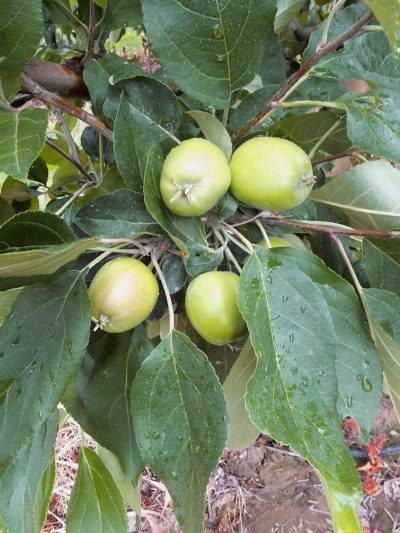
Apple growers typically worry about having too much fruit on the tree, rather than too little. But some varieties, including Minneiska, the apple marketed under the SweeTango brand, can be prone to poor fruit set.
Growers of these varieties in Michigan are showing more of an interest in using the plant growth regulator ReTain to improve fruit retention, said David Jones, a fruit tree educator with Michigan State University Extension.
Michigan apple growers use ReTain (aminoethoxyvinylglycine) to reduce fruit drop, delay harvest, improve fruit firmness, prolong flower longevity, increase color, improve finish, extend shelf life and stagger the harvest, according to Jones. It delays ripening and senescence by inhibiting the biosynthesis of ethylene.
Minneiska, a popular club variety, is sometimes prone to shy bearing. Growers expressed interest in using ReTain to shut down the variety’s ethylene peak, which could improve fruit retention and therefore boost bearing. The technique could work for other shy-bearing apples, too, including Golden Supreme and hard-cider varieties, Jones said.
When apples bloom, they produce a lot of ethylene, which ages flowers and shrinks the window for pollination, fertilization and fruit set. ReTain slows that process by shutting down ethylene production, said Philip Schwallier, an MSU specialty crop production educator.

Jones and Schwallier conducted a field trial in 2019 to demonstrate ReTain’s potential in a commercial Minneiska orchard with a history of poor fruit set in West-central Michigan’s Oceana County.
The trees in the trial were planted on Malling 26 rootstocks in 2007. Trained as a high-density fruiting wall, the trees were uniform in size and bloom strength. According to Jones, four groups of 115 trees were treated with ReTain at king bloom petal fall at a rate of half a pouch per acre. The remainder of the orchard was left untreated.
Jones said treated trees showed a “pretty strong response” to the plant growth regulator. ReTain-treated trees achieved a fruit set at least 20 percent greater than the untreated trees. Jones would like at least one more year of tests to confirm the data, but he was encouraged by the results of the trial.

Each variety is unique, however. Minneiska produces a surge of ethylene seven to 10 days after bloom, but other shy-bearing varieties might have different timings. Peak ethylene production should be pinpointed for each variety before using ReTain to increase fruit set, Jones said.
ReTain also appears to help even out fruit set within an orchard canopy. Some blocks or varieties tend to have poor fruit set on the bottom of the tree but not the top. ReTain is locally systemic, so growers can spray it only on parts of the tree that need a fruit set boost, Jones said. Untreated areas will not respond.
“Shy bearers are where you really get a bang for your buck,” Schwallier said, but the plant growth regulator “also could help in the bottom half of the tree, where maybe you don’t get good fruit set.”
The only risk Schwallier sees is the possibility of oversetting a crop.
“If ReTain is sprayed on a tree that already has good set, it would increase set to perhaps too heavy of a crop load,” Schwallier said, “but you normally don’t see that.” •
—by Matt Milkovich
Correction: This article has been updated to clarify the difference between the variety name, Minneiska, and the brand name it is marketed under, SweeTango.






According to our 3 years studies on the Minneiska variety (SweeTango), the peak of ethylene is much higher than any other apple variety and peak reaches it maximum anytime time from full bloom to 10 days after bloom, depending on the year. We couldn’t find yet a weather correlation that could help us identify when the peak would occurs. However, all ReTain treatments applied during this period gave us great results, being a split application the most successful.